Structural Cost Savings. Lightweight Vs Heavyweight Roofing
It is generally accepted that structural framing requirements for a lightweight roof are less than for a heavyweight roof and can result in cost savings.
The degree of these cost savings is often debated, so the NZMRM engaged an independent consultant to look at the savings that could be achieved using a lightweight roof.
This work was carried out by an independent consultant, Mike Flooks of MF Design Ltd. Mike Flooks is well respected in the industry and has just been appointed Chairman of the board of the Architectural Designers NZ Inc.
The review has now been completed and the findings show that significant structural costs savings are achievable when using lightweight roofing materials compared to using heavyweight roofing materials.
An NZMRM Information Bulletin has been prepared titled – “Lightweight vs Heavyweight Roofing Structural Cost Comparison”.
This bulletin summarizes the findings and provides advice on how builders, designers and merchants can maximise the cost savings for their clients through using a lightweight roof. 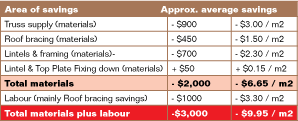 EXECUTIVE SUMMARY
EXECUTIVE SUMMARY
The average approximate structural cost savings using a lightweight roof compared with a heavyweight roof were as follows:
METHOD
Three typical single storey roof designs were chosen. The structural requirements for a heavyweight roof and lightweight roof were then optimised to the minimum allowable under current standards, primarily using NZS3604. The costs for these structural requirements were then compared.
The following design parameters were used:
Design Wind Speed: High
Design Earthquake Zone: C
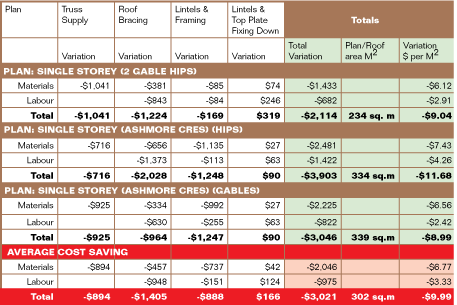 RESULTS
RESULTS
Table 1 - Structural savings for a lightweight roof vs a heavyweight roof.
Designer managing project: Mike Flooks - MF Design Ltd.
Quantity Surveyor: Quantech Consultancy Ltd.
Structural Engineer: Airey Consultants Ltd.
Note: The full structural comparison table, methodology and summary notes is available from www.metalroofing.org.nz
DISCUSSION
The analysis of these plans shows that significant structural cost savings are achievable when using lightweight roofing materials compared to using heavyweight roofing materials.
Savings achieved could be higher or lower depending on house design and location. For example the design parameters chosen for these plans are generally considered less favourable to lightweight roofing. Additional structural savings are likely to be achieved in lower wind zones, higher earthquake zones and if moving to two storey construction.
It should be noted that lightweight structural cost savings will increase as more gables are present in the roof design.
How you can achieve lightweight structural savings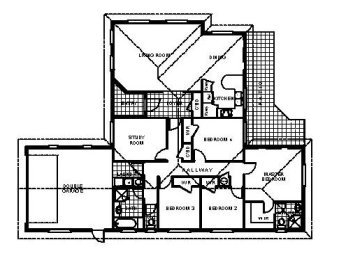
Truss supply
Truss design and pricing is determined by the frame & truss merchant. Check that your frame & truss merchant is optimising the truss design for a lightweight roof, that they are providing separate truss prices for lightweight roofing and that they are passing on the full cost savings to you.
Roof bracing
Roof bracing design is determined by the designer. It has been found that it is common to “over brace” roofs which incurs additional cost. By referring to the appropriate tables and specifying roof bracing to the minimum, good material savings can be achieved in this area. Additional labour savings for roof bracing could also be achieved if builder’s payment methods accommodate this. 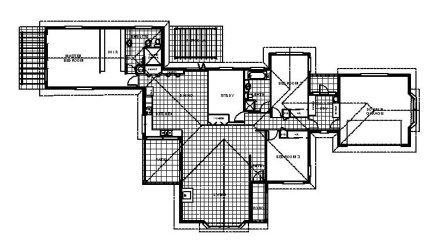
Lintels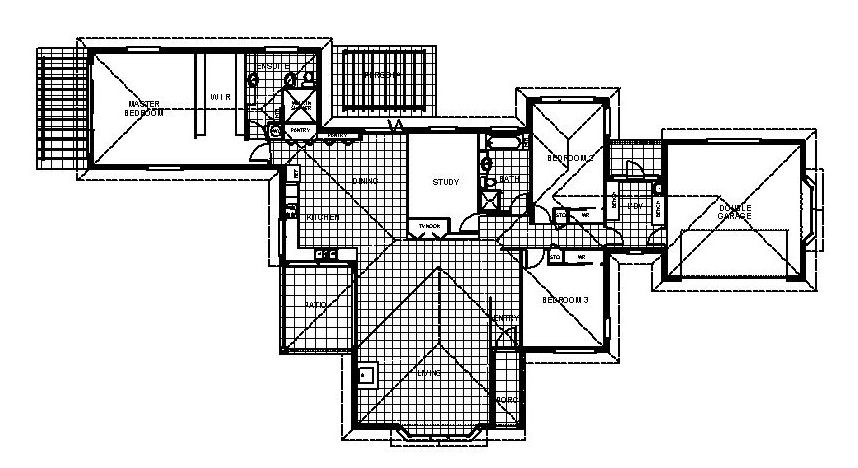
Lintel design is determined by the designer. By referring to the appropriate tables and specifying lintels to the minimum good material savings can be achieved in this area.
Lintel & top plate fixing hold downs
There is an additional cost in this area for a lightweight roof that is small compared to the savings in other areas.
DESIGN TIPS / CONSIDERATIONS FOR ROOF BRACING, LINTELS AND FIXING DOWNS
These design tips have been prepared by Mike Flooks of MF Design Ltd to assist designers to optimise specification of Roof Bracing, Lintels and Fixing Downs.
Definitions & Notes:
Generally it is recommended that a preliminary truss layout be completed by a truss fabricator prior to completing construction drawings, this should also include fixing down of trusses to top plates.
Generally a hip roof has roof planes on adjacent sides rising in part or full toward a common ridge over external walls.
Generally a gable roof is a roof which has two opposing roof planes rising to a common ridge, forming a triangle shaped wall below on one or both ends.
A light roof is a roof with roofing material (cladding and sarking) having a mass not exceeding 20 kg/m2 of roof area i.e. Longrun profiled metal, pressed metal tiles.
A heavy roof is a roof with roofing material (cladding and sarking) having a mass exceeding 20 kg/m2 of roof area but not exceeding 60kg/m2 i.e. concrete tiles, slate.
Roof Bracing:
Refer to “Summary of Roof Bracing Systems” Table 10.1 NZS3604” for bracing Requirements
Roof areas less than 6.0m2 do not require bracing (e.g. dormers and porches)
Open areas below exceeding 6.0m wide require Dragon ties or Ceiling diaphragms.
Ceiling Plane Braces (CPB) - (As required in table 10.1) Place at 2.5m centers max. to top plates supporting hip-end jack trusses or jack rafters and connect to a brace wall below (Not required if the top plate is a boundary member of a ceiling diaphragm) All to NZS3604.
Roof space braces (RSB) – (As required in table 10.1) Place at each gable end, not more than 7.5m centers along the ridge and ensure not less than 2.0m from a parallel external wall. Provide at least half the braces within 2.0m of the ridge. RSB’s in elevation, shall not be steeper than 45º and brace runners shall be within 300mm of a parallel brace wall below or over a ceiling diaphragm. All to NZS3604.
Roof Plane Braces (RPB) – (Where required) Either a timber member or a “pair: of diagonally opposing strip braces with tensioners at not greater than 45º to the ridge in plan view, running from the ridge to the external wall. ( May be omitted if sarking or a complying ceiling diaphragm is fixed to the “underside of the rafters” ) All to NZS3604.
A hip or valley rafter running from the ridge to the top plate ( or extended to do so) can be counted as a roof plane brace for both roof plans in L shaped roofs.
Lintels and Fixings Downs:
Top Plate fixing down - Consider what is most cost effective and appropriate to use: NZS3604 or an alternative solution , e.g. Lumberlok etc. Ensure correct loaded dimensions are used from the tables in all instances.
Lintel design (including beams) – Consider what is most cost effective and easy for the Builders to install, Timber - NZS3604, LVL – Lintel design software, steel or an alternative solution.
Lintel fixing down (including beams) - Consider what is most cost effective and appropriate to use NZS3604 fixings or an alternative solution e.g. Lumberlok etc.
NZMRM engaged an independent consultant, Mike Flooks - MF Design Ltd. to calculate these potential cost saving when using lightweight roofing materials and to provide tips and considerations in roof design.
Design tips / considerations prepared by:
Mike Flooks - MF Design Ltd
Quantity Surveyor: Quantech Consultancy Ltd
Structural Engineer: Airey Consultants Ltd
